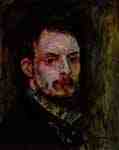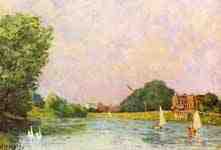Sterling and Francine Clark Art Institute, Williamstown (Massachusetts)

Death and the maidens, Pierre-Cécile Puvis de Chavannes
 Self-portrait, Pierre-Auguste Renoir
Self-portrait, Pierre-Auguste Renoir

Thames at Hampton Court, Alfred Sisley

Doge's Palace, Venice, Felix Ziem
The Sterling & Francine Clark Art Institute, usually referred to simply as "The Clark", is an art museum with a large and varied collection located in Williamstown, Massachusetts, United States. Along with the Massachusetts Museum of Contemporary Art (MassMoCA) and the Williams College Museum of Art (WCMA), it forms a trio of significant art museums and resources in the north of The Berkshires. In June 2008 it expanded with the addition of the Stone Hill Center, a 32,000-square-foot (3,000 m2) building designed by Tadao Ando on a nearby wooded hillside that contains exhibition space and a conservation studio.[1] The Clark has the dual role of serving as a museum and a research institute, and is home to the Research and Academic Program, which offers semester-long fellowships to scholars and hosts many public lectures throughout the year. It is also the seat of the Williams College Graduate Program in the History of Art. [2]
History
Origins
"The Clark" was created by entrepreneur, soldier, explorer, and prominent art collector Robert Sterling Clark, and his wife, Francine. After numerous adventures in the Far East, Sterling settled in Paris in 1911 and used a considerable fortune inherited from his grandfather (a principal in the Singer Sewing Machine Company) to begin a private art collection. Francine joined him in collecting after they married in 1919.
The Clarks kept their collection entirely private, rarely lending out any works. By the late 1940s, however, they became worried about the safety of their artwork. With the onset of the Cold War and rapid nuclear armament, they wanted to protect their collection from the possibility of an attack on New York City, where they lived and the home of the Metropolitan Museum of Art (which many had expected to be the heir to the Clarks' collection). The Clarks began looking at sites in rural New York and Massachusetts with the intention of founding a museum for their art.
They visited Williamstown, Massachusetts in 1949 and began having conversations with town leaders and the administrators of Williams College and the Williams College Museum of Art. Sterling had ties to the college through his grandfather and father, both of whom had been trustees. A charter for the Clark was signed on March 14, 1950 and the Institute opened to the public on May 17, 1955. The Institute has since become a significant destination for tourists, art lovers, and scholars. It has helped establish the cultural reputation of The Berkshires.
Expansion
The original marble gallery building, designed by Daniel Deverell Perry (1905 - 2002), opened in 1955. In 2001,[3] the Clark retained the services of architect Tadao Ando to design a major addition to the buildings and campus. The project was completed in July 2014. The New York architect Annabelle Selldorf was commissioned to renovate both of the existing older structures, increasing exhibition space in the original building by 15% and added galleries for the American and decorative art collections.[4] The landscape firm Reed Hilderbrand reconfigured the grounds, including revamped walking trails, planting 1,000 trees and creating a reflecting pool fed by recycled water.[3][4]
Programs
The Clark offers a wide range of educational programs and opportunities. In addition to artwork, it houses a major art conservation center and art history library. Relations with Williams College continue to be friendly and students from the college are admitted for free. It also co-sponsors the College's famed graduate program in the history of art, from which many current museum curators graduated. The Institute sponsors a number of fellowships, lectures, colloquia, conferences, and performing arts programs every year.
Collection
At first, the Clarks concentrated on Italian, Dutch, and Flemish Old Master paintings. Eventually, their interests turned to more recent artists and they developed a great affinity for the works of John Singer Sargent, Edgar Degas, Winslow Homer, and Pierre-Auguste Renoir. After 1920, the Clarks focused mainly on the art of 19th-century France — specifically works of Impressionism and the Barbizon School. Over the ensuing 35 years, they amassed a collection of stunning quality and breadth. It included paintings, porcelain, silver, prints, and drawings from the 14th to the 19th centuries, by both famous and (then) completely obscure artists.
Since 1955, the Clark has continued to acquire artworks, with a recent focus on expanding its photography collection. Today, it is best known for works of French Impressionism, especially the paintings of Renoir, academic paintings by Jean-Léon Gérôme and William Bouguereau, and a fine collection of British and American silver.
Clark Prize for Excellence in Arts Writing
The Clark Prize for Excellence in Arts Writing has been awarded every other year since 2006. The prize "celebrates informed, insightful, and accessible prose that advances the public understanding and appreciation of the visual arts." [5] The award is presented for "critical or historical writing that conveys complex ideas in a manner that is grounded in scholarship yet appealing to a diverse range of audiences."[5]
In 2006, the first year, three people were honored. Since then, one person has been selected each time it has been awarded.[6] Winners of the Prize are:
2012: Brian O'Doherty
2010: Hal Foster
2008: Peter Schjeldahl
2006: Kobena Mercer, Linda Nochlin and Calvin Tomkins
Management
The museum's most recent $145 million expansion project has been funded through private donations, foundation support, the Massachusetts Cultural Facilities Fund, and bond financing organized in conjunction with the Commonwealth of Massachusetts.[4]
References
October 2008 Forbes Life page 50
The Graduate Program Website: http://web.williams.edu/gradart/
Ted Loos (March 28, 2014), From Divergence, a Thoughtful Calm: Tadao Ando’s New Work at the Clark Institute New York Times.
Julia Halperin (July 4, 2014), Clark Art Institute's expansion paves the way for major loans The Art Newspaper.
http://www.clarkart.edu/about/content.cfm?ID=308
http://www.clarkart.edu/about/content.cfm?ID=455
---
Fine Art Prints | Greeting Cards | Phone Cases | Lifestyle | Face Masks | Men's , Women' Apparel | Home Decor | jigsaw puzzles | Notebooks | Tapestries | ...
---
Artist
A - B - C - D - E - F - G - H - I - J - K - L - M -
N - O - P - Q - R - S - T - U - V - W - X - Y - Z
Retrieved from "http://en.wikipedia.org/"
All text is available under the terms of the GNU Free Documentation License


